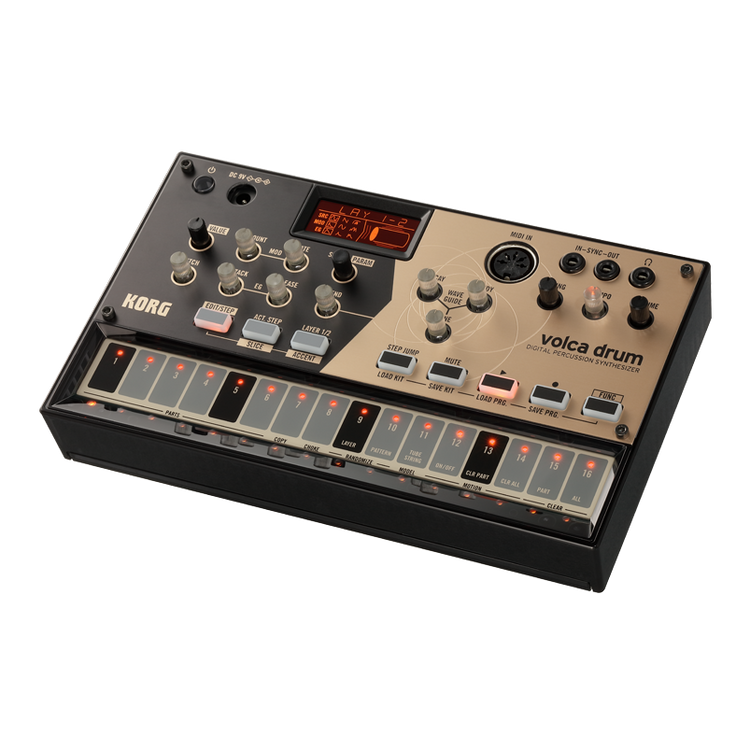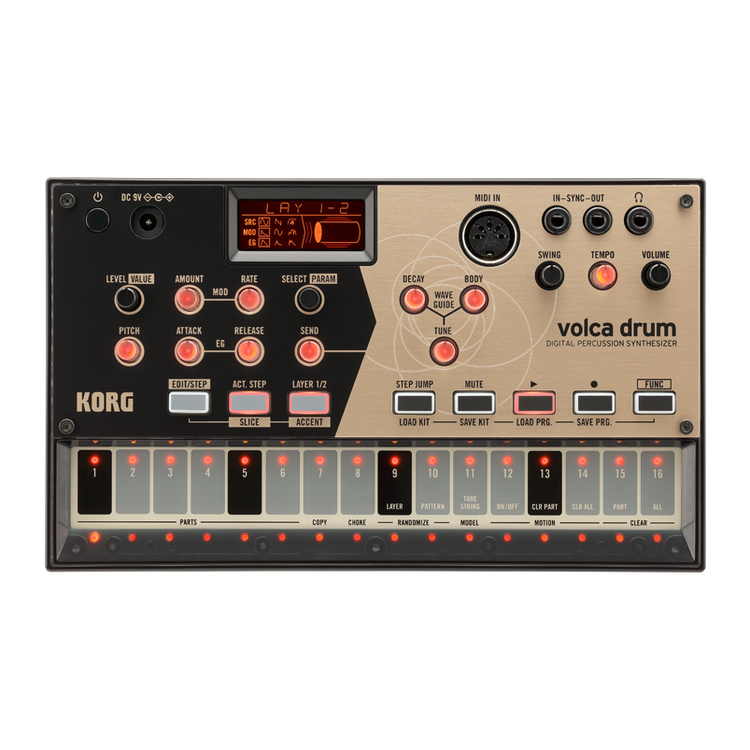Korg Volca Drum
- Regular price
- $159.99
- Sale price
- $159.99
- Regular price
-
- Unit price
- per
The six-part DSP synth engine of the volca drum was designed with a completely different philosophy than conventional drum machines, and generates a wide range of unexpectedly different sounds. Based on a simple trigger waveform, wave folder and overdrive are used to add overtones and distortion, and then a waveguide resonator effect brings the sound to life.
The term "digital" typically brings to mind sounds that are based on PCM-sampled bass drum, snare drum, or cymbal, but the volca drum creates its drum sounds by DSP-powered analog modeling. Oscillator waveforms such as sine wave, sawtooth wave, and noise are provided. By applying various changes to these waveforms, you can create a wide variety of percussion sounds that range from realistic to idiosyncratic, and are not limited only to drums.
The six parts each have two layers, and do not impose any rules or restrictions such as specifying which parts must be used for the bass drum or for the cymbal; all parts have the same specifications. You can freely assign your new sounds to these six parts without being limited by the conventions of a drum set. A kit consists of the six parts that you've assigned plus the waveguide resonator effect settings, and 16 such kits can be stored in memory (the factory settings contain 10 preload kits).
Each part consists of two layers. For each layer, users choose one of five types of oscillator waveform including sine wave, sawtooth wave, and HPF noise, and also choose from three types of pitch modulator and amp EG, each optimized for drum sounds. Layer parameters can be edited either individually or simultaneously, and users can also use the two layers to produce the same sound for additional thickness.
You can customize the resulting trigger waveform by applying bit reduction to produce roughness, adjusting the wave folder depth to add complex overtones, and using overdrive to adjust the distortion. In this way, you can generate distinctive sounds from this sound engine that's structured rather differently from a typical drum machine.
The effect section features a waveguide resonator that's based on physical modeling, and which adds sympathetic resonances to the sound. You can choose from two types of waveguide: "tube" which adds the resonance of a cylindrical object such as a drum body or a long pipe, or "strings" which adds the metallic resonance of a string. The three knobs located in the center of the panel let you specify the DECAY (amount of attenuation), BODY (sonic character), and TUNE (pitch). Setting TUNE to a lower value will produce a delay-like behavior. You can take advantage of these knobs not only for sound design but also in your live performances.
The 16-step sequencer is excellent for improvisation. You can easily create patterns using the 16 buttons, each corresponding to one of the 16 steps. In addition to step recording, the sequencer also supports realtime recording in which you can construct a pattern while looping the playback. The pattern chain function lets you play multiple sequence patterns successively, so you can successively play back desired patterns of consecutive numbers. Up to 16 sequences can be connected to construct patterns with 256 steps.
There's an active step function that lets you skip steps during sequence playback. This can be used to create "short loop" effects and irregular rhythms, or you can even create polyrhythms by using different settings for each part.
The step slice function lets you play drum rolls. You can set accents to create strong beats at specific steps, not simply as an on/off setting but in a range of 16 levels, allowing you to express a subtle sense of groove and rhythmic nuance. There's a choke function that lets you specify which of multiple parts should take priority when sounded simultaneously, such as the hi-hat closed and open sounds of a drum machine.
The six-part DSP synth engine of the volca drum was designed with a completely different philosophy than conventional drum machines, and generates a wide range of unexpectedly different sounds. Based on a simple trigger waveform, wave folder and overdrive are used to add overtones and distortion, and then a waveguide resonator effect brings the sound to life.
The term "digital" typically brings to mind sounds that are based on PCM-sampled bass drum, snare drum, or cymbal, but the volca drum creates its drum sounds by DSP-powered analog modeling. Oscillator waveforms such as sine wave, sawtooth wave, and noise are provided. By applying various changes to these waveforms, you can create a wide variety of percussion sounds that range from realistic to idiosyncratic, and are not limited only to drums.
The six parts each have two layers, and do not impose any rules or restrictions such as specifying which parts must be used for the bass drum or for the cymbal; all parts have the same specifications. You can freely assign your new sounds to these six parts without being limited by the conventions of a drum set. A kit consists of the six parts that you've assigned plus the waveguide resonator effect settings, and 16 such kits can be stored in memory (the factory settings contain 10 preload kits).
Each part consists of two layers. For each layer, users choose one of five types of oscillator waveform including sine wave, sawtooth wave, and HPF noise, and also choose from three types of pitch modulator and amp EG, each optimized for drum sounds. Layer parameters can be edited either individually or simultaneously, and users can also use the two layers to produce the same sound for additional thickness.
You can customize the resulting trigger waveform by applying bit reduction to produce roughness, adjusting the wave folder depth to add complex overtones, and using overdrive to adjust the distortion. In this way, you can generate distinctive sounds from this sound engine that's structured rather differently from a typical drum machine.
The effect section features a waveguide resonator that's based on physical modeling, and which adds sympathetic resonances to the sound. You can choose from two types of waveguide: "tube" which adds the resonance of a cylindrical object such as a drum body or a long pipe, or "strings" which adds the metallic resonance of a string. The three knobs located in the center of the panel let you specify the DECAY (amount of attenuation), BODY (sonic character), and TUNE (pitch). Setting TUNE to a lower value will produce a delay-like behavior. You can take advantage of these knobs not only for sound design but also in your live performances.
The 16-step sequencer is excellent for improvisation. You can easily create patterns using the 16 buttons, each corresponding to one of the 16 steps. In addition to step recording, the sequencer also supports realtime recording in which you can construct a pattern while looping the playback. The pattern chain function lets you play multiple sequence patterns successively, so you can successively play back desired patterns of consecutive numbers. Up to 16 sequences can be connected to construct patterns with 256 steps.
There's an active step function that lets you skip steps during sequence playback. This can be used to create "short loop" effects and irregular rhythms, or you can even create polyrhythms by using different settings for each part.
The step slice function lets you play drum rolls. You can set accents to create strong beats at specific steps, not simply as an on/off setting but in a range of 16 levels, allowing you to express a subtle sense of groove and rhythmic nuance. There's a choke function that lets you specify which of multiple parts should take priority when sounded simultaneously, such as the hi-hat closed and open sounds of a drum machine.
- Distinctive sound from a newly developed DSP engine
- 6 note polyphony
- Multi touch trigger pads / Step keys
- Sync In and MIDI In
- Waveguide resonator adds rich resonances
- 16-step sequencer with a wide range of parameter automation
- ACTIVE STEP lets you replace steps for each part
- Slice function finely divides a step to allow drum-rolls
- Accent function that can be specified in 16 levels
- Compact, size, battery operation, and built-in speaker for playing on the go

